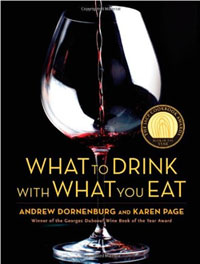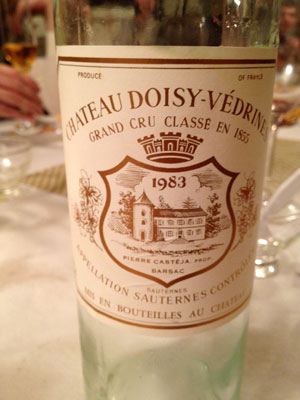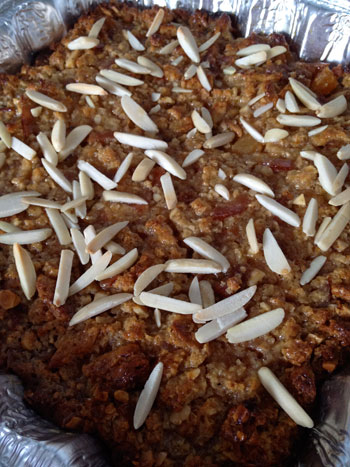
Food and wine pairing. Everyone tries to do it well. Most of the time, you go by the old standards - steak with Cabernet, white wine with fish - with the best of intentions just hoping that they don't clash, but praying you hit it just right. You're hoping, praying you get the perfect mouthful, where the wine and food meld together into something unexpected, complementing and enhancing one another into a perfect delicious union. When that happens, and it's not often enough, it's truly magical.
There are countless books written on the subject. The "bible" being What to Drink with What You Eat. My copy is so over-used the binding has separated, causing pages to fall out whenever I open it. This book includes just about every food (though oddly not potatoes, but an entire section of cheese) and just what types of beverage (beer, cocktails and tea included) you should pair with each ingredient. We drink wine almost everyday in our house and it's been my passion over the last few years to try to not only become a better cook, but to be more successful at wine pairing. It's a frustrating, hit and miss operation.
What makes it worse is the fact that I usually hit the nail on the head when I don't actually follow a recipe, but mash a few together to accommodate what I have in my fridge and pantry. While these meals are a delight and help boost my confidence in the kitchen, they make me sad and a little angry when they're over because I won't be able to duplicate the experience. I never write it down because I go by taste and feel. Great for the dish, bad for posterity. I know it should be more about the journey, blah, blah, blah, but it would be great to have a few pairing/recipe locks in my repertoire.
One of my most recent hit mash-ups was developed for my wine tasting group. Instead of just drinking, I mean tasting, on a specific theme, we decided to try our hands at a wine pairing dinner. Having no idea the level of culinary skills of the other's in the group, it was a bit of risky business; however, everyone jumped in with abandon and in the end performed quite admirably with nary a misstep.
 I wanted to share a 750ml bottle of 1983 Doisy-Vedrines Sauternes with the group since most of the them are just beginning their wine journey and I knew none of them, including me, had ever had a wine that old…or much experience with this luscious dessert-style, type of wine. The fact that the bottle was older than one of the members is still a shock to my system. And made me a bit jealous. I have never had the pleasure of that sort of occasion and probably never will. Bottles from the 60s are rare and most definitely out of my price range. C'est la vie.
I wanted to share a 750ml bottle of 1983 Doisy-Vedrines Sauternes with the group since most of the them are just beginning their wine journey and I knew none of them, including me, had ever had a wine that old…or much experience with this luscious dessert-style, type of wine. The fact that the bottle was older than one of the members is still a shock to my system. And made me a bit jealous. I have never had the pleasure of that sort of occasion and probably never will. Bottles from the 60s are rare and most definitely out of my price range. C'est la vie.
Sauternes is a sweet, white wine made in Bordeaux from a mixture of Semillon, Sauvignon Blanc and Muscadelle grapes that have been affected by noble rot, which in the case of this wine is a very, very good thing. Since the conditions have to be just right - you want the good rot, not the bad there is a difference - these wines are not made every vintage. This makes them even more precious and expensive, though a half-bottle can usually be purchased between $20-$30. A small price to pay in my book for an exceptional bottle of wine. Most of the time I just drink it straight, in place of dessert, but for this party I had to come up with a pairing that would enhance the wine without overpowering it.
The flavors of Sauternes vary from winery to winery, but generally consist of a mixture of stone fruits (peaches/apricots), tropical fruits (mango/pineapple), citrus (lemon/orange), honey, almond with notes of honeysuckle, toast, coconut and beeswax. Grapes that have been affected with noble rot also have a distinct quality on the nose, that is hard to describe but once you encounter is hard to forget. In a good way. Having never had this particular wine, I wanted something sweet but not super sugary. When pairing wines with dessert you always want the wine to be sweeter. Otherwise it can make the wine taste thin and lifeless.
Since I am not a baker, I had to come up with something that didn't really require much skill, was portable and could be reheated without much trouble. Using my previously touted "mash-up" skills I crafted a bread pudding that was a perfect complement to the wine. Everybody said so. Even I ate my fair share and, like I said, I don't eat dessert. Just drink it.
The basis for the recipe was a super-simple biscuit bread pudding created by Chef Rusty Hamlin. His version is killer and includes peanut butter and chocolate. I needed mine to incorporate the flavors I believed would be found in the wine, so I substituted dried apricots, almonds and orange marmalade. Instead of the rum sauce, I used slightly-melted mango honey. It was sweet, but not overly so and truly made the wine taste better. Frankly, if I had know how good it was going to turn out, I wouldn't have been so eager to share…
Apricot Blood-Orange Almond Biscuit Bread Pudding
 8 buttermilk biscuits (I use Trader Joe's, bake them the morning of and just leave out on the counter uncovered until I'm ready to bake the pudding)
8 buttermilk biscuits (I use Trader Joe's, bake them the morning of and just leave out on the counter uncovered until I'm ready to bake the pudding)
1 cup whipping cream
1 cup unsweetened Vanilla-flavored almond milk
1 cup chopped dried apricots
1/2 toasted, unsalted almonds, chopped (candied pecans could work too I think)
1/2 cup blood orange marmalade (regular orange will work fine)
2 eggs
1 teaspoon cinnamon
1/2 teaspoon nutmeg
1/2 teaspoon ginger
1 cup sugar (I used Stevia, which isn't as sweet as regular white)
1 cup brown sugar
1/2 cup mango honey, slightly melted
1/4 untoasted almonds for topping, if desired
Preheat over to 400°F.
Using a large mixing bowl, crumble all of the biscuits into tiny, 1/2-inch chunks. Add in the apricots, nuts, sugars and spices and give the mixture a good toss. Add in the eggs, whipping cream, almond milk and marmalade all at the same time. Stir it all up, making sure everything is evenly distributed and all the biscuit pieces are moist. It should be fairly drenched but without any standing liquid in the bottom of the bowl. Add more almond milk if it seems too dry.
Butter a 9"x13" baking dish. Pour in the bread pudding and bake covered with foil for 45 minutes to an hour. Once the center is mostly set (it stops jiggling) remove from the oven and pour the warmed honey (about 15-20 seconds in the microwave) across the top. (Skip this step if going to bake and serve at a later time.) Sprinkle top with additional nuts, if using. Return to the oven uncovered and bake for another 15-20 minutes until the top is lightly browned. Let sit for 5-10 minutes to cool slightly, then serve.
--If you are going to bring this to a party or want to merely reheat it later in the day, stop the baking at an hour. Let it come to room temperature and then place in the fridge until dinner time. Take out and return to room temp. Then add the melted honey and reheat for half an hour at 250°F until warm, browned and fully cooked through.
Lisa Dinsmore is a writer, web programmer, movie and wine lover. She currently runs two review websites to share her passions: www.crazy4cinema.com and www.dailywinedispatch.com. She is also the Managing Editor of One for the Table.

